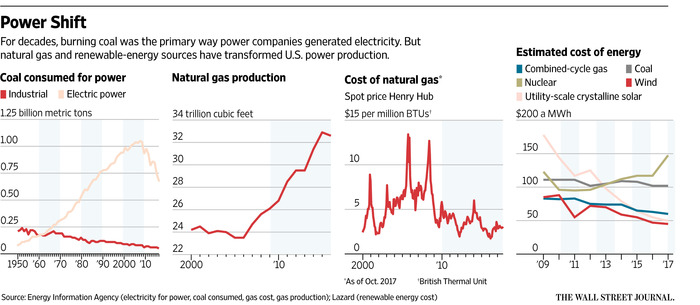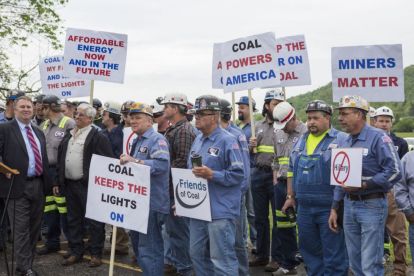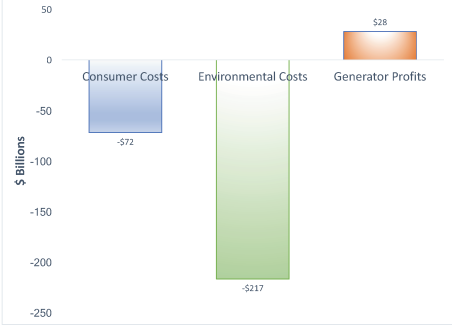The Decline of Coal: Break the Fall or Soften the Blow?
Propping up domestic coal demand is an expensive snooze button.
The decline in U.S. coal-fired electricity generation is a good news/bad news story, depending on your perspective. The good news is that, as coal gets displaced by cleaner fuels, the climate changes more slowly, and we all breathe easier. But the pictures below also represent evaporating profits, lost livelihood, and devastated coal communities.

Dimming U.S. prospects for Old King Coal (Source: Wall Street Journal, Nov. 20, 2017)
Transformative changes often disrupt industries and displace incumbent technologies. Think VHS tapes, rotary phones, typewriters. But the declining domestic coal sector requires particular attention from policymakers.
One reason is that the environmental and public health consequences are significant. Another is that the closure of coal plants and coal mines can devastate local labor markets. Although the coal sector accounts for a small share of US employment, coal is the lifeblood of some communities. Coal miners have become emblematic of the painful transition that can ensue when an external shock (be it globalization, technological innovation, or regulation) wipes out local labor demand.

Source
Last week, I was reminded that these challenging tradeoffs are not confined to the United States. I was in Alberta, where everyone’s talking about coal’s reversal of fortune. Alberta sits on 70 percent of Canadian coal reserves. Demand for coal has declined by 42% since 2005. Although the fuel transition challenges have much in common with the U.S., the policy responses could not be more different.
Can Trump save coal (and at what cost)?
On the campaign trail, Trump promised to bring back the coal industry. Many (myself included) scoffed at this idea given the market fundamentals that are driving coal’s decline. But I underestimated how far this administration is willing to go to save the domestic coal industry.
Some actions were predictable. The leasing moratorium for federal coal has been lifted. Environmental protections have been eliminated. And if environmental regulations were really to blame for the decline of domestic coal, the administration could have stopped here. But the evidence so far suggests the decline in coal demand has primarily been driven by cheap gas and stagnant load growth. If the domestic coal sector is to be saved, Trump needs to dig deeper.
Cue the DOE proposal to pay large subsidies to coal (and nuclear) plants. This “Grid Resiliency Pricing Rule” fails to identify any real market failure in need of a solution. As far as I can tell, its primary purpose is to prop up a domestic industry in decline.
According to the Energy Information Administration, 51,795 people were working in coal mines in 2016. Tens of thousands more are working in related fields (e.g. power plants.) Most of these jobs are in economically challenged regions. As the coal sector contracts, these workers will not seamlessly transition to some other part of the economy. Previous research has shown that the costs of this kind of labor reallocation can be high, particularly in areas where the local economy is weak.
There are all sorts of reasons to be concerned about – and responsive to – these local labor market impacts. But propping up domestic coal demand in an effort to delay or avoid these impacts is the wrong response. Some recent reports assess just how costly this DOE rule could be. For example, this study from Resources for the Future estimates large subsidy payments, environmental damages and consumer impacts over the years 2020-2045:

Consumer costs reflect the cost of the profit guarantee net of any impacts on wholesale electricity prices. Environmental impacts account for increases in SO2, NOx, and CO2 net of any decreases associated with extending the life of nuclear plants. See the paper for details
Taking these net cost estimates at face value, this is an excessively high price to pay for avoided/delayed worker displacement and ill-defined resiliency benefits.
Alberta aims to smooth the transition
Looking north, the policy response to the decline of coal looks a lot different. Alberta has committed to phasing out coal-fired electricity by 2030 and phasing in broad-based carbon pricing. The province wants to implement these policies while also (1) maintaining investor confidence; (2) maintaining electric system reliability; and (3) ensuring workers and communities are treated fairly.
Alberta’s transition from coal to natural gas and renewables will require lots of new investment. In response to concerns that investors would shy away from a province that stranded large coal generation assets, Alberta hired Terry Boston (of PJM fame) to broker a deal with power companies. $1.1 B (funded by carbon revenues) will be paid out to compensate coal generating facilities with end-of-life dates after 2030.
On the reliability front, coal retirements and the increased investment in renewables could potentially create challenges. With these concerns in mind, Alberta’s system operator has considered a variety of market reforms (including a return to cost of service regulation). The AESO has decided to supplement the province’s energy-only market with a capacity market.
Finally, the province is investing in Alberta’s coal communities and helping workers to transition out of the coal sector. Carbon tax revenues will be used to supplement employment insurance, corporate partnerships, and retraining programs. This sounds good. But it could be the plan’s weakest link. Unfortunately, the track record for job retraining programs is not great. Although there are some innovative ideas circulating about how outcomes could be improved.
Break the fall or soften the blow?
The Trump administration’s current strategy is, on balance, short-sighted and extremely costly. Liquidating federal coal reserves at bargain basement prices, derailing environmental protections, and subsidizing unprofitable coal plants could shore up coal sector jobs for a time. But this comes at a very high cost to consumers and the environment.
Had the 2016 election turned out differently, we would be seeing something like the Alberta plan unfolding here in the U.S. In addition to environmental protections, Hillary Clinton had proposed a $30 billion plan to expand support for public health, education, and entrepreneurial initiatives in coal communities. Needless to say, this plan was soundly rejected by coal communities with comments like: “It’s not a plan. It’s a care package.”
Well-intentioned arguments in support of job retraining programs need to be backed by compelling evidence of positive outcomes. Let’s hope that program experimentation in Alberta (and elsewhere) can find ways to smooth the job transition for workers caught on the wrong side of the energy transition.
Categories

In 2016 I led a paper called “Decline of Coal—Driven by Policy or Technology? A Study” that integrated only hard data to answer the subject question. It was published in The Electricity Journal in Sept 2016. The conclusions at 5,000 feet are the same as yours except we side-stepped the electro-political questions of jobs, health, and climate. Those are all very real, but being prospective in nature they are more a subject of partisan attacks that deflect the reality that coal plants are closing — on average — because we can lower your electricity bill by building gas-fueled plants instead. …And as utility-scale batteries get here shortly, coal won’t be able to compete with wind and solar either
If anyone’s interested, the 11-page, small-font paper was reviewed kindly in an easier-to-digest 1-1/2 pages by University of Pennsylvania at http://kleinmanenergy.upenn.edu/blog/2016/10/13/natural-gas-war-coal.
Thanks, Walt
Founding Board Member
Great Lakes Energy Institute at
Case Western Reserve University
http://energy.case.edu/
Finally, a real world example of how benefit-cost analysis should be used in practice. Alberta takes the revenues that represent a portion of the society wide benefits and distributes those to the losers from the policy change. Economists have almost always ignored the problem of how to compensate losers in changes in social policy, and of course those who keep losing increasingly oppose any more policies. Instead of dreaming up ways to invest carbon market revenues in whiz bang solutions, we first need to focus on who’s being left behind so they are not resentful, and become a key political impediment to doing the right thing.
Thanks for your post! The debate about how to phase-out coal in an orderly way is key to create momentum in the regions more dependent on it for their economic survival. I enjoyed reading some time ago about the experience of ditching coal in some parts of Germany: https://ensia.com/features/german-transition-coal-renewable-energy/
I cannot help being surprised by the level of attention to the social problems derived from the decline of coal. The decline of other jobs has gone largely unnoticed. Years ago, I recall my uncle (a retired civil engineer) telling me how he used to live with his and a dozen other families in a town created for the development, operation and maintenance of one of the largest hydropower plants in Spain. More than a decade ago, the town vanished. All is left now is a completely automated plant managed remotely, that only receives the occasional visits of a maintenance technician.
There are more than 5 Americans working in solar or wind for each American working in coal. There is around one American working in natural and advanced gas for each American working in coal. If anything, the decline of coal is good news for the US. I think you rightly point to the key challenge: how to redistribute the benefits for most Americans to compensate those few getting hurt by it.
Thanks again and best,
Alejandro
Rather than short-sighted and costly patches, policies should take the long view (transition to clean energy) and address the local jobs issues directly.
The decline in coal for power generation fuel is directly attributable to two factors. Foremost is the lower price of natural gas as a fuel for power generation. Low gas prices have been eating coal’s lunch for some time and savaging it in competitive wholesale markets. Coal plant retirements are directly related to that fall-out.
The second factor contributing to coal use decline is the regulatory limitation on use of coal as a power generation fuel such as California’s outright ban on purchase of power by regulated utilities where coal is the fuel source.
The consequence of these factors is that coal exports are growing as producers switch their focus from domestic markets to international ones.